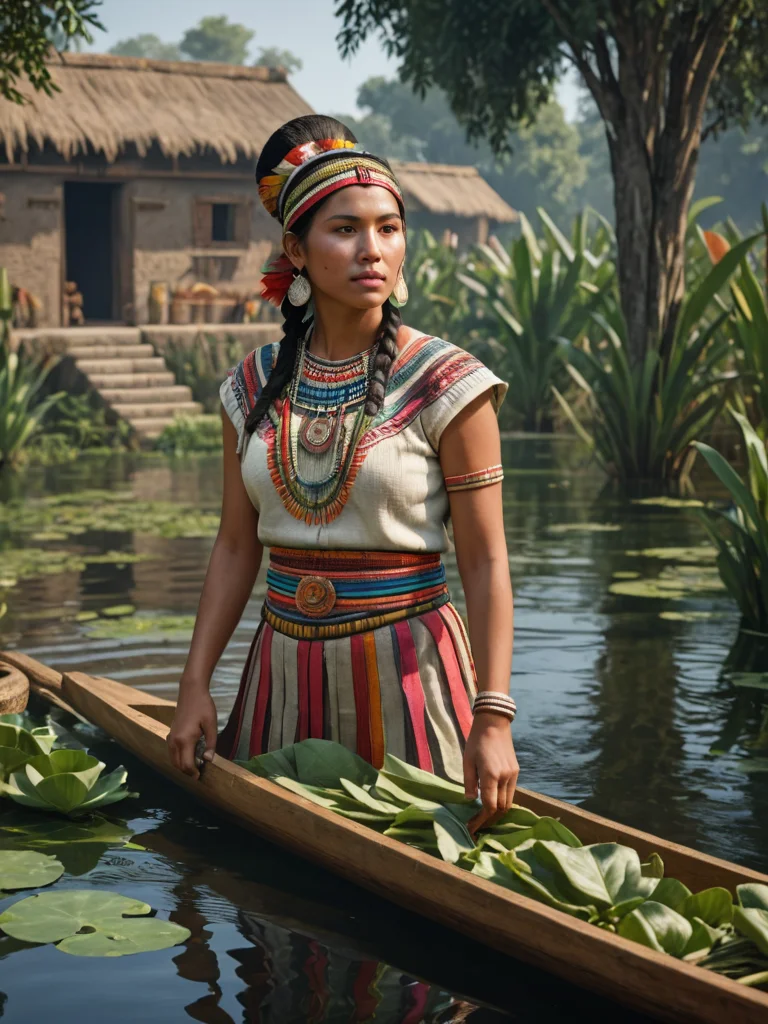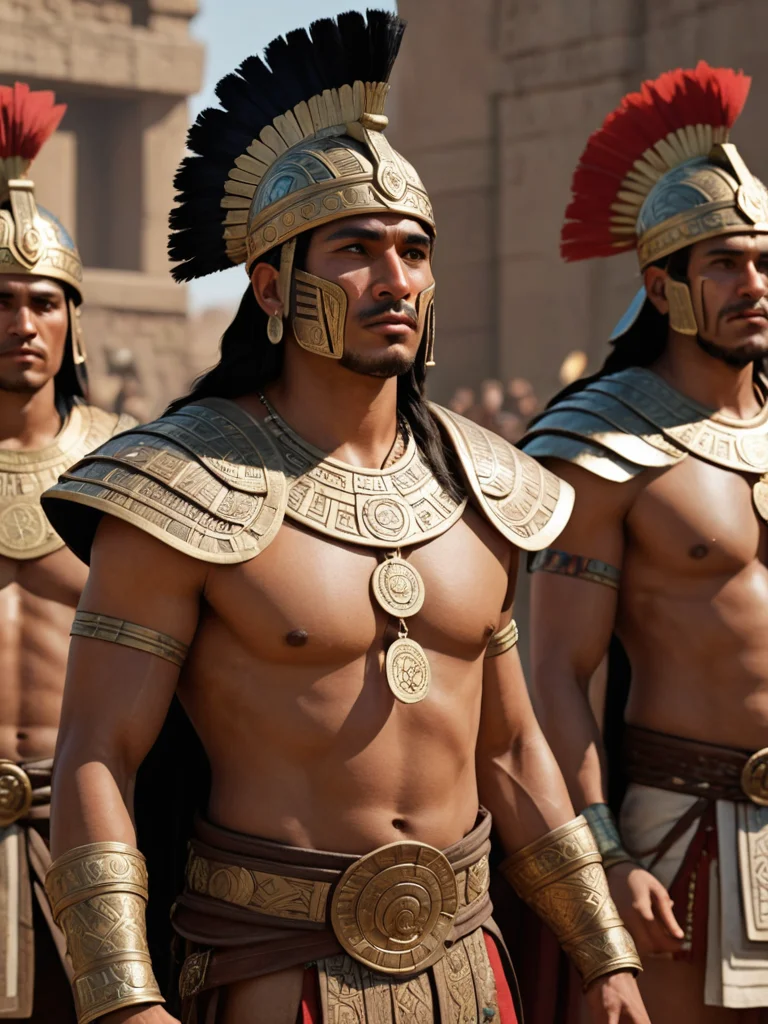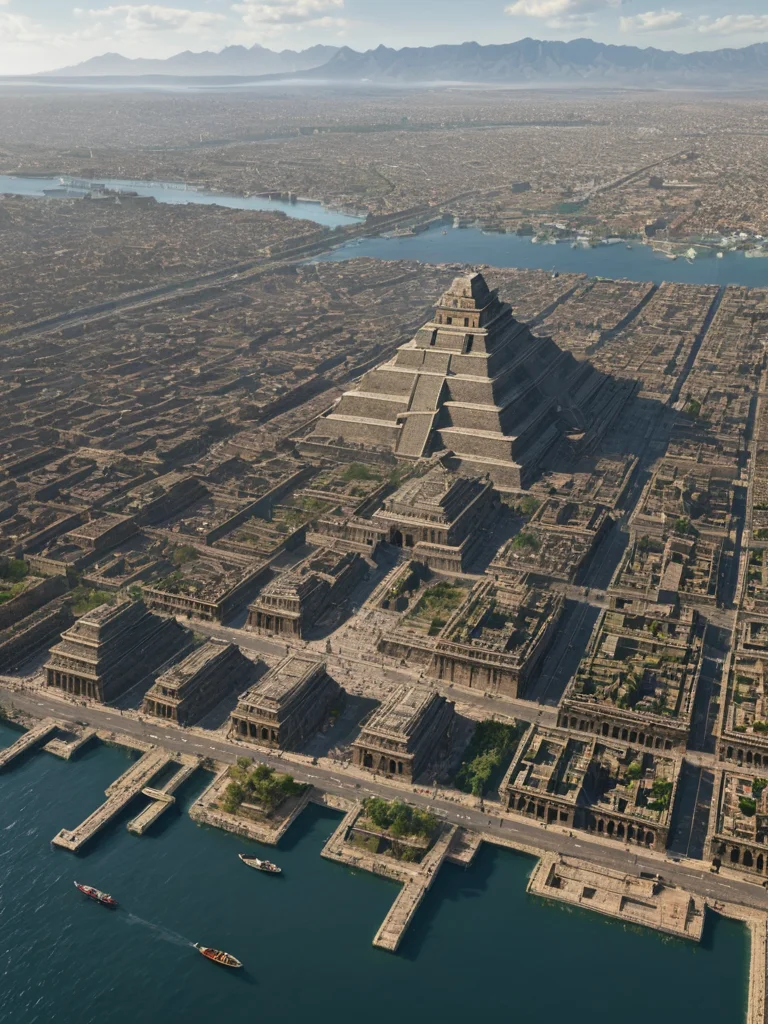Imagine a city rising from the middle of a vast lake, where canals serve as streets and houses and temples are built on artificial islands. A city where thousands of people flock daily along roads connecting it to the mainland to trade, pray, and live a vibrant life. This was Tenochtitlan – the capital of the mighty Aztec Empire, a unique creation of human thought and labor, which emerged in the middle of Lake Texcoco in present-day Mexico.
It was not just a settlement, but a whole metropolis of its time, which, according to historians’ estimates, may have had 200-300 thousand inhabitants by the early 16th century, placing it on par with the largest cities in Europe of that period, such as Paris or London. But, unlike European cities, Tenochtitlan was built on water, making its architecture and engineering solutions truly astonishing. The founding of the city is shrouded in legend: according to tradition, the Mexica tribe (as the Aztecs called themselves) wandered in search of a place indicated to them by the god Huitzilopochtli. He promised them a sign – an eagle perched on a cactus devouring a snake. According to legend, they saw exactly this sign on a small island in the middle of the lake, and there, in 1325, the construction of the great city began.
From a humble settlement on a small island, Tenochtitlan quickly transformed into a thriving center, expanding thanks to the ingenious chinampa system – floating gardens that not only provided the city with food but also effectively increased its area. A system of dams, aqueducts, and canals sustained the life of this amazing city, allowing for water level control and the delivery of fresh water from the mainland. Mighty temples, majestic palaces, and wide markets testified to the wealth and complex organization of Aztec society. By studying the life and customs of the Aztecs, we embark on a fascinating journey through time to understand how this remarkable civilization lived, whose achievements and tragedies still evoke admiration and bewilderment.
Aztec Life: From “Floating Gardens” to Everyday Rituals
The daily life of the Aztecs was closely intertwined with their surrounding nature and complex belief system. At the heart of their life, undoubtedly, was agriculture, and its jewel was the famous chinampas – the so-called “floating gardens.” These were true engineering structures: in the shallows of Lake Texcoco, the Aztecs created artificial islands from silt, soil, and vegetation, enclosed by woven branches. Plant roots penetrated through the silt to the very bottom of the lake, ensuring constant moisture and nutrient supply. Thanks to this unique farming method, the Aztecs could harvest several crops a year, which allowed them to feed a huge population. The main crops were, of course, corn, beans, squash, chili peppers, as well as amaranth and chia.
The Aztec diet was quite varied, although its basis consisted of plant products. Maize (corn) was the king of the table; it was used to make flatbreads – tortillas, an analogue of bread. These were supplemented with beans, squash, various vegetables and fruits, and, of course, chili peppers. Sources of protein included turkeys, dogs, fish, waterfowl, and insects. The Aztecs also consumed spirulina – blue-green algae from the lake, making a kind of flatbread from it. An important drink was pulque – a low-alcohol drink made from agave sap, and cocoa beans, although used as currency, were used to prepare the bitter drink xocolatl, which was mainly available to the nobility.
Aztec houses were typically built from adobe bricks or stone, with roofs of straw or reeds. Inside, cleanliness and order prevailed. A typical house had one or two rooms, with a hearth in the center around which the family gathered. Furniture was minimal: woven mats for sleeping, low tables, and chests. Most of life took place outdoors. The Aztecs paid great attention to hygiene: they regularly bathed in public temazcal baths, resembling modern saunas, and used plant-based remedies for body care.
Aztec clothing was simple but practical. Men wore loincloths (maxtlatl) and cloaks (tilmatli), which varied from simple cotton to richly decorated ones for the nobility. Women wore skirts (coyutl) and sleeveless blouses (huipil), often embroidered. Status was often determined by the quality of the fabric, color, and complexity of embroidery. Warriors and nobles had the right to wear luxurious jewelry made of feathers, precious stones, and gold.
The heart of social and economic life were the markets, or tianguis. The largest market in Tenochtitlan was located in the Tlatelolco district and was an astonishing sight. Tens of thousands of people flocked here daily to buy or sell literally everything – from food to textiles, ceramics, jewelry, feathers, and even slaves. Cocoa beans and pieces of cotton cloth served as the main forms of currency. Strict order was maintained here by overseers. The market was not only a place of trade but also a center for communication and status display.
Aztec family life was patriarchal, but the role of women in the family was very significant. Men were engaged in agriculture, crafts, and warfare, while women were responsible for household chores, cooking, raising children, and weaving. Children were taught from an early age to work and be disciplined. Marriages were usually arranged, but divorces were possible. Child-rearing was strict but loving, with an emphasis on instilling respect for elders, diligence, and piety.
The education system was one of the most developed. For the sons of nobles, there were calmecac – schools where they were taught history, religion, astronomy, rhetoric, warfare, and administration. For the children of commoners, there were telpochcalli – schools where the main focus was on physical training, agriculture, crafts, and basic military skills. Girls were educated at home by their mothers. The goal of education was not only to impart knowledge but also to form worthy citizens.
Aztec medicine was surprisingly advanced. They possessed extensive knowledge of the medicinal properties of plants and minerals, used acupuncture, and performed complex surgical operations, including trepanation of the skull. Illnesses were often associated with imbalances in spiritual equilibrium, so treatment was accompanied by rituals. However, their practical skills were impressive; for example, they knew how to set splints for fractures.
Leisure and entertainment also played an important role. One of the most popular games was tlachtli – a ritual ball game, reminiscent of modern basketball. The ball, made of rubber, had to be thrown into a stone hoop. This game often had a ritualistic character. Music, dances, and poetry were an integral part of festivals and daily life, often having religious significance. The Aztecs were skilled musicians, using drums, flutes, and shells.
Aztec Customs and Laws: What the Aztecs Valued and How They Lived by the Code of the Gods

Aztec society was strictly hierarchical, with clearly defined roles for each member. At the top was the tlatoani – the emperor, considered a descendant of the gods. Below him was the extensive nobility (pilli): priests, military leaders, officials. Their privileges were numerous. Then came the warriors, whose status depended on their exploits; military campaigns were a path to social advancement. The main mass consisted of ordinary farmers and artisans (macehualtin), united in communities (calpulli), which owned land collectively and paid tribute. At the very bottom were slaves (tlacotli), but their slavery was not hereditary and often temporary, related to debts or punishments. Slaves could buy themselves out.
The Aztec legal system was strict and unambiguous, reflecting their desire for order. Laws were strictly enforced, and violations were severely punished. Crimes that might result in a fine in other cultures were often punishable by death among the Aztecs. Thus, theft, adultery, public drunkenness, lying, and sometimes even disrespect for elders could cost a life. Each crime had its own punishment, often public. Courts were multi-tiered. Aztec justice was aimed not only at retribution but also at restoring social balance. Even noble people were not fully protected from punishment.
Warrior culture held a central place. The Aztecs were a warrior people, and war was an integral part of their existence, serving several purposes. First and foremost, it was a means of expanding the empire and obtaining tribute. Secondly, war provided a supply of captives for ritual sacrifices. Thirdly, military campaigns were the main path to social advancement. Young warriors strove to capture prisoners to prove their valor. Distinguished warriors could join elite orders, such as the Jaguar Warriors and Eagle Warriors, who wore impressive armor. Discipline, courage, and self-sacrifice were the highest virtues.
Religion permeated all aspects of Aztec life. The Aztecs were polytheists, worshipping a pantheon of gods. The main ones were Huitzilopochtli (god of sun and war), Tlaloc (god of rain and fertility), Quetzalcoatl (creator god). The Aztecs believed in the cyclical nature of time and the world; according to their cosmology, humanity lived in the era of the Fifth Sun, which was doomed to destruction if not “nourished” by blood and hearts. This belief formed the basis of their rituals.
Aztec values were deeply rooted in their religious and social beliefs. They valued teotl – divine power permeating the world. The main virtues were considered piety, bravery, discipline, diligence, modesty, respect for elders and authorities, and readiness for self-sacrifice for the community and the gods. Children were taught from an early age to be obedient and hardworking. Unlike European societies, where wealth was often an end in itself, among the Aztecs it served as an indicator of status and the ability to benefit society. Public censure was a powerful tool of social control.
Aztec art and crafts were inextricably linked to their religion. They were outstanding masters in stone carving, creating monumental sculptures, temples, and palaces. Their exquisite gold and silver work is well-known. A special place was occupied by feather art, amauatl: vibrant feathers were used to create incredible mosaics, headdresses, and cloaks for nobles and warriors. Ceramics, textiles, and paintings on codices also demonstrate a high level of craftsmanship and deep symbolic meaning, conveying the myths, history, and laws of the Aztec world.
The Dark Side of Beliefs: Why Did the Aztecs Sacrifice Humans?

One of the most complex and debated aspects of Aztec civilization is the practice of human sacrifice. For modern people, this tradition seems cruel. However, for the Aztecs, it was not just a ritual but a vital necessity, deeply rooted in their worldview. Historians agree that it is impossible to understand the motives of the Aztecs without delving into their religious system.
At the core of Aztec beliefs lay the concept of the “Five Suns.” The Aztecs believed that the world had been created and destroyed four times already, and they lived in the era of the Fifth Sun. For this Sun – the god Huitzilopochtli – to continue its journey across the sky and ensure life on Earth, it had to be constantly “fed” with the most valuable substance: human blood and hearts. Without this, they believed, the Sun would stop, and the world would plunge into darkness. Thus, sacrifices were not an act of cruelty but, in their understanding, a sacred duty to the gods, aimed at maintaining cosmic order and the survival of humanity.
Sacrifices were not uniform and varied depending on the deity and the purpose of the ritual. The most common form was the extraction of the heart from a living person at the top of a temple pyramid. Victims dedicated to Huitzilopochtli were usually prisoners of war captured during “flower wars.” The victim was laid on an altar, and a priest extracted the beating heart with an obsidian knife. The body was then often thrown down the pyramid steps.
In addition to Huitzilopochtli, sacrifices were made to other gods. For example, children whose tears were believed to bring rain might be sacrificed to the god Tlaloc. Victims to the god Xipe Totec might have their skin flayed. Other forms existed: beheading, burning, drowning, ritual gladiatorial combat. The number of victims could reach thousands in a single major ritual, such as the consecration of new temples. Sources indicate that during the consecration of the Great Temple in 1487, tens of thousands of people may have been sacrificed, although modern historians dispute the accuracy of these figures, considering them exaggerated.
The sources of victims were diverse. Most often, they were prisoners of war. The Aztecs rarely killed enemies on the battlefield, preferring to capture them alive. Slaves, criminals, and sometimes even Aztecs themselves, who voluntarily offered themselves as sacrifices or were chosen based on special criteria, considering it the greatest honor, could also become victims. In some cases, these were professional sacrificial victims who lived in luxury for a year and were then sacrificed.
Besides the religious aspect, human sacrifices played an important socio-political role. They served as a powerful tool of intimidation for conquered peoples, demonstrating the empire’s strength. The rituals were public and grand, strengthening the authority of the priesthood. Furthermore, some historians hypothesize that, in conditions of a rapidly growing population and limited resources, sacrifices could indirectly serve as a population control mechanism or even as a food source in ritual cannibalism, although the latter is a subject of intense scientific debate. For the Aztecs, this practice was an integral part of their worldview, an act of deep faith, and an attempt to ensure the survival of their world.
The Legacy of the Aztecs: Lessons from the Past and Influence on the Present
Although the Aztec Empire fell under the onslaught of the Spanish conquistadors in 1521, its rich and complex legacy continues to live on and influence the modern world, especially Mexico, which is the direct heir to this ancient civilization. Studying the Aztecs provides us with valuable lessons about the diversity of human cultures, their ability to adapt to complex conditions, and the unpredictable turns of history.
One of the most obvious manifestations of Aztec heritage is language. Although Spanish is the dominant language of Mexico, the Nahuatl language, spoken by the Aztecs, is still used by millions of indigenous people. Many words from Nahuatl have entered Spanish, and then into other languages of the world. For example, words like chocolate, tomato, chili, avocado, coyote, and many others have Aztec origins, testifying to cultural exchange.
The culinary heritage of the Aztecs is also invaluable. Staple foods like corn, beans, squash, and chili peppers remain the cornerstone of Mexican cuisine. Tacos, tortillas, guacamole, mole – all these dishes have roots in Aztec culinary tradition. Corn, which the Aztecs considered a sacred gift from the gods, is still the basis of the diet for most Mexicans. This is a vivid example of how ancient eating habits have survived centuries and become part of the global culinary map.
In art and architecture, modern Mexico proudly displays its Aztec roots. The symbol of an eagle devouring a snake on a cactus, from Aztec legend, has become the central element on the national coat of arms of Mexico. Numerous archaeological sites, such as the remains of the Great Temple in Mexico City, and museums housing Aztec artifacts attract millions of tourists and researchers. Modern artists and artisans draw inspiration from Aztec patterns, preserving ancient traditions.
The Aztec civilization, with all its complexities and contradictions, is a powerful reminder of the diverse paths of human development. It demonstrates an amazing ability to create complex social structures, advanced agricultural technologies, and grand cities. At the same time, it is also a lesson about the clash of civilizations and the consequences of conquest.
By studying the Aztecs, we not only learn about the past but also gain food for thought about the present. Their history makes us reflect on the nature of power, the role of religion in society, the significance of cultural values, and how our own worldviews shape our attitudes towards others. The legacy of the Aztecs is not just majestic ruins and museum exhibits; it is a living part of Mexico’s cultural identity and an important contribution to universal human history, continuing to inspire and provoke questions.
